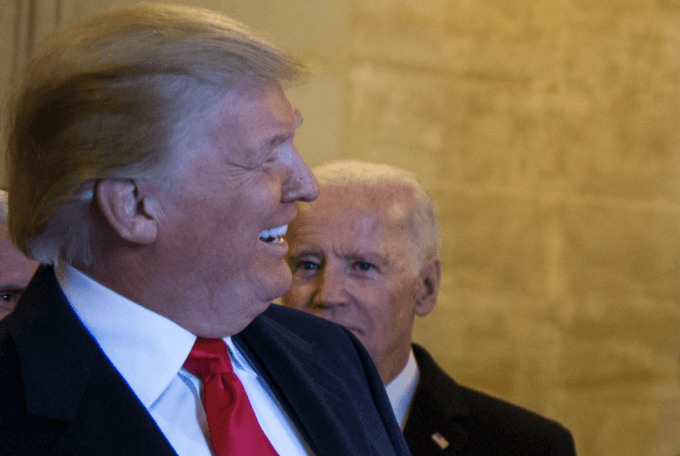Biden v. Trump: the Economy and Blue Collar Jobs

Photograph Source: Staff Sgt. Marianique Santos – Public Domain
While immigration and abortion are the two hottest issues driving voters’ passion, the national economy has remained one of the public’s top three concerns for years.
More recently, in three 2023 polls the Wall Street Journal conducted from April to December, the economy ranked as the top issue out of twelve.
Those surveyed were asked: What issue is most important to you when thinking about who you will vote for in the 2024 Presidential Election? Republicans have been hammering Biden’s administration for soaring inflation and hurting our economy even while they contributed to it.
At the end of his first year in 2021, Senate Minority Leader Mitch McConnell accused Biden of causing inflation, saying, “The last thing we need to do is pile on with another massive, reckless tax and spending spree.”
McConnell ignored that both parties were responsible for the consumer price index (CPI) increasing at a 5% annual rate for the first half of 2021.
Congressional Republicans and Democrats overwhelmingly passed over $2 trillion of economic stimulus legislation in response to COVID in Trump’s last term in office. The legislation stopped the economy from collapsing when the pandemic threw millions of workers out of work and halted many business operations.
Trump signed the legislation and took credit for providing $1,200 checks to individuals and $790 billion in low-interest loans to small businesses through the Paycheck Protection Program (PPP) when the program ended in the fifth month of Biden’s first year in office, 96% of those loans had been forgiven.
These federal funds saved the economy but also triggered inflation, stoked further by the Federal Reserve Board, significantly increasing bank borrowing rates.
However, the U.S. was not alone in having to deal with inflation. It climbed to the highest level since 2008 in the Organization for Economic Cooperation and Development’s 38 member countries. It was also due to COVID shrinking the labor force and stimulating consumer demand as the pandemic receded.
Former President Donald Trump ran a TV campaign ad just before Biden gave his State of the Union address, saying that “Biden refuses to talk about the unfairness of his disastrous, failed ‘Bidenomics’ policies,”
Trump’s hyper-accusation is faulty. Nevertheless, food costs were relatively flat under Trump’s administration before the economic impact of COVID kicked in during the last half of Trump’s final year.
In the first year of Biden’s term, food costs soared to over 6%. That increase was directly due to COVID’s impact on reduced labor and materials supplies, as more dollars were pumped into the economy bidding for fewer goods.
The politics of blaming Biden for many of the economic problems spawned by COVID may have pushed the polls to show that their economic welfare fell under President Joe Biden’s administration.
In the eight polls that WSJ conducted from March 2022 to February 2024, just over half of the respondents strongly disapproved of how Biden handled the economy, specifically inflation and rising costs. Those who strongly approved never exceeded 19% until the last poll in February, when they hit 23%. This is good news for Biden, but he still faces a 50% strong disapproval rate.
Trump’s campaign capitalized on these findings. “President Biden, the polls are accurate. Americans just don’t like you for destroying our economy,” said Jason Miller, a senior Trump campaign adviser.
It is essential to note which party the WSJ poll respondents are affiliated with. Until February, Republican-affiliated respondents were 31%, and Democrat-affiliated respondents were 34%. Independents have remained constant at nine and ten percent. The percentages of Republicans and Democrats flipped in the last poll, which showed 31% for Democrats and 34% for Republicans.
There is some evidence that independent voters might be inclined to support Biden. In a pre-speech poll of Biden’s State of the Union, independents who believed his economic policies would move the US in the right direction jumped from 41% to 61% afterward.
A Biden information campaign could resonate with independent voters if they are swayed more by data than party allegiance. If so, independents might look closely at what both campaigns are saying to see if it aligns with reality.
The most significant slice of the populace, regardless of party affiliation, are wage workers. They are concerned with having a job and making enough to keep up with inflation. In their State of the Union (SOTU) speeches, both Trump and Biden made a pitch to them.
Job Creation
In his last SOTU, Trump said seven million new jobs had been created since his election.
When Trump spoke, he was correct. However, the coronavirus was already spreading across the globe, and within weeks, the U.S. economy was shut down, throwing millions of people out of work. As a result, Trump ended up with more than 3.1 million jobs in the hole because of pandemic employment losses.
In his STU, Biden disputed Trump’s claims by presenting good economic news from the first three years of his administration. He proudly said that during this time, “15 million new jobs in just three years — a record, a record!”
Delivering federal money to aid businesses to continue operating during COVID played a significant role in that expansive number. It may be that up to eleven million of those new jobs were due to workers returning to jobs they had lost.
Nevertheless, data from the U.S. Bureau of Labor Statistics shows that Biden created more jobs over a shorter period than Trump.
Trump’s peak of non-farm employment in February 2020 was 152 million; it took him three years to add 6 million workers since he started his presidency. After that February, the pandemic struck the economy, and employment plummeted to 109 million by April 2020.
Biden’s peak of non-farm employment was 158 million in February 2024; it took him three years to add 15 million workers from when he started his presidency.
The bottom line is that job creation expansion occurred under both administrations, but it contracted sharply when COVID hit the entire population.
The emergence of COVID, or any natural disaster, goes beyond any president’s control.
However, how they respond and how funds are used determines their effectiveness in dealing with these events. Biden responded very well by creating more jobs faster than before the pre-COVID economy under Trump’s administration.
Blue Collar Wages
Democrats are distressed by their blue-collar voter base swinging over to the Republicans.
They lean on Republicans’ cultural war against the “elites,” i.e., liberals and Democrats, for an explanation.
There is some truth on how the liberal cultural agenda threatens many established conservative values by promoting affirmative actions, more accessible admittance for asylum seekers, and institutional protections for all minorities — including race, gender, and sexual identification.
However, in the field of economic welfare, Democrats cannot understand how working-class families could support a narcissistic billionaire who gives out-sized tax benefits to corporations and comparatively meager ones to working families. The answer may rest in the fact that under the Trump Administration, paychecks rose.
A president’s chance of winning reelection is often based on how most voters have experienced the economy during the last four years. A good economy is whether paychecks grow faster than prices in “real” (inflation-adjusted) terms.
The average weekly earnings of all private-sector workers, in “real” terms, rose 8.7% in Trump’s four years. More germane for Democrats is that the blue-collar wages for rank-and-file production and nonsupervisory workers — who make up 81% of all private-sector workers — went up 9.8% under Trump.
Workers probably don’t care that those gains were an extension of a trend that started after the 2007–2009 recession. During the last Democratic term, the Obama years, real weekly earnings rose 4.2% for all workers and 4% for rank-and-file. However, what workers do care about are the last four years under the Biden Administration.
Unfortunately for Biden, as Matt Bruenig, writing for the socialist magazine Jacobin, explains, real wages have declined under Joe Biden’s Presidency. Bruenig writes, “ It’s clear that most workers saw their real wages decline throughout nearly all of 2021 and 2022.
His chart shows that the median usual weekly real earnings of full-time workers rose from the beginning of 2018 to the spring of 2020 while Trump was in office. Afterward, they fell dramatically for the next 24 months and only then began a modest rise. By December 2023, real wages were only $3 higher than when COVID started four years earlier.
In brief, Bruenig makes it “clear that most workers saw their real wages decline throughout nearly all of 2021 and 2022.” That fact explains how the cultural war alone does not account for most blue-collared workers supporting Trump.
Biden’s Way Forward
It is easy to understand why WSJ’s polls showed many workers felt better off under the Trump administration. The steady rise in their real wages contracted during Biden’s administration when the brunt of COVID’s constraints on business activity landed.
While economic stimulus funds, supported by both parties, softened COVID’s impact on most workers, they also fed inflation, which the independent Federal Reserve Bank contributed to by increasing interest rates. Rising inflation reduced the margin between stalled wages and rising consumer costs.
History shows that both Trump and Biden supported government intervention in the marketplace, pouring historically high amounts of federal dollars into it to avert an economic recession. Inflation and job fluctuations resulted in both cases.
If Biden tries to validate his economic policies by explaining complex data, he will lose his audience to Trump, who has spent his life promoting his successes, real or not. He ignores critical details that compromise their importance because he knows how to captivate an audience through extravagant feats against a common enemy.
The Democratic message should be that Biden, as the helmsman, steered this country back into calmer waters. He successfully managed the most significant sudden infusion of federal funds and regulations the U.S. had seen since the Great Depression.
Biden’s economic policies followed up on the bi-partisan effort to avoid a financial collapse due to COVID. And he did so without blaming others for our condition.

